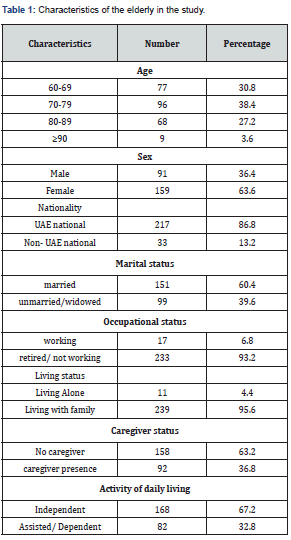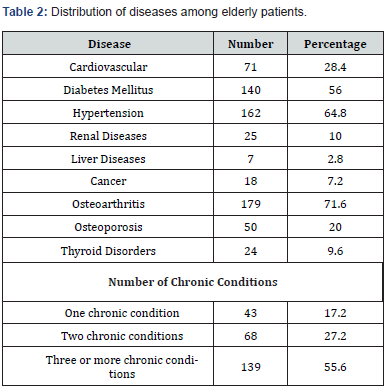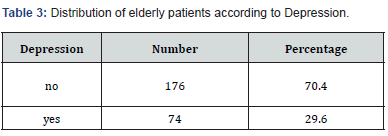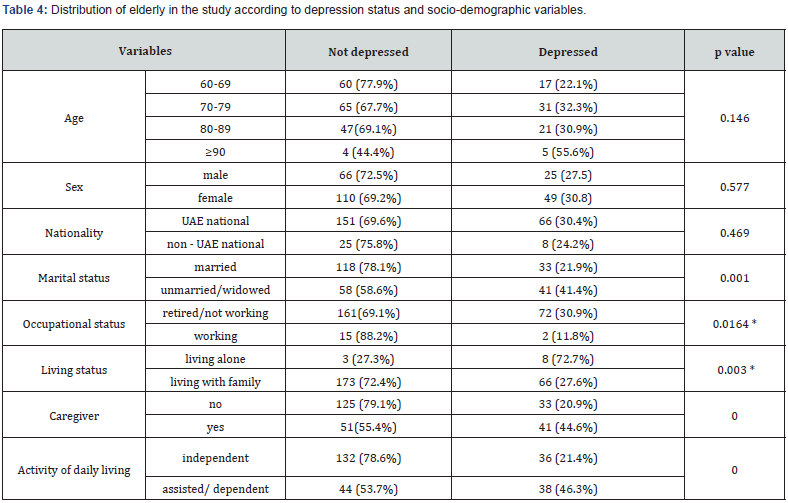Depression Among Elderly Attending Dubai Primary Health Care Centers: A Cross Sectional Study
Anood Alshaali*, Mona El Sherbiny, Soha Abdel Aziz, Mohammed Hammam, Amal Aljaziri, Mohammed El Noamani and Tamer Farid
Geriatric medicine section- Dubai Academic Health Corporation, Dubai
Submission: September 12, 2023; Published: September 20, 2023
*Corresponding author: Anood Alshaali, Geriatric medicine section, Dubai Academic Health Corporation, Dubai
How to cite this article: Anood A, Mona El S, Soha Abdel A, Mohammed Hammam, Amal A, et al. Depression Among Elderly in Primary Health Care: A Cross Section Study. OAJ Gerontol & Geriatric Med. 2023; 7(4): 555716. DOI: 10.19080/OAJGGM.2023.07.555716
Abstract
Mental disorders are among the most prevalent chronic diseases of the elderly worldwide, with depression being one of the most common geriatric mental disorders. A cross sectional study was conducted with a sample of 250 elderly, using a structured questionnaire. The mean age was 74.8 ± 8.2, and almost two third were females. The prevalence of depression in this study was 26.6%, higher among female than male (30.8% versus 27.5%). Early detection and treatment of depression will improve the patient’s quality of life and enhance recovery. This data will assist to plan mental health initiatives aimed at screening and early interventions.
Keywords: Depression; Mental Health; Mental Disorders; Aging
Keywords: ADL: Activities of Daily living, GDS: Geriatric Depression Scale, SPSS: Statistical Package for Social Science
Introduction
Mental disorders are among the most prevalent chronic diseases of the elderly worldwide, with depression being one of the most common geriatric mental disorders. [1] Depression is a disabling condition that increases the risk of mortality and reduces the quality of life of elderly. It also leads to higher care burdens for family members and caregivers [2,3]. The clinical picture of depression in elderly, is sometimes masked by memory difficulties with distress and anxiety symptoms therefore it is commonly misdiagnosed and under treated [4]. Moreover, depression is undiagnosed in about 50% of cases. This could be due to the widespread belief that depression is normal with aging [5]. According to the WHO global burden of disease report, depression was projected to be the first leading cause of disease burden worldwide by 2030 [6].
A systematic review and meta-analysis published in Neuroscience & Biobehavioral Reviews reported that the prevalence of major depressive disorder in elderly worldwide is 13.3% [7] A study on Subjective life satisfaction and mental disorders among older adults in UAE in general population conducted by Ghubach et al. [8], reported that the prevalence rate for depression as high as 20.2% [8]. The US Preventive Task Force (USPTF) recommends that all individuals older than 60 years be periodically screened for depression [9]. There are many screening instruments available to detect depression among the elderly. The Geriatric Depression Scale-15 (GDS-15) is a valid instrument and is widely used for evaluating depression in the elderly [10]. The GDS-15 has been translated into many languages, including Arabic. The GDS-15 may be used in any setting, acute care, primary care, home care, assisted living, or long-term care [11]. The prevalence and epidemiological data of patients with depression are limited. Having this data is useful to assist in planning mental health initiatives aimed at early interventions and screening.
Objective
This study will estimate the prevalence of depression among elderly attending primary health care center facilities.
Methodology
Study Design and Setting
A cross sectional study was conducted in geriatric clinic in Dubai primary health care centers.
Population and Study Sample
Patients attended the geriatric clinic in primary health care centres July - November 2022.
Sample Size and Selection of Sample
Sample size was calculated using 20.2% estimated prevalence of depression in elderly, 5 % degree of precision and 95% confidence level. The minimum sample size required was 248. Patients attended geriatric clinics in primary health care centres.
Data collection
Data were collected from the patients through personal interview after explanation about the purpose and scope of the study and their informed consent was received.
A predesigned structured questionnaire consisted of two parts. The first part was sociodemographic and included clinical data such as age, sex, marital status, occupational status, activity of daily living and any current diseases. The second part was Geriatric Depression Scale-15 (GDS -15).
Activities of Daily living (ADL)
Activities of Daily Living (ADL) scales were used to measure functional abilities. It focuses on six basic activities: bathing, dressing, toileting, transfer, continence and feeding. Each activity is categorized as follows (independent, assisted, totally dependent). A score of (1) means independent, score of (2) means assisted and score of (3) means totally dependent. The maximum total score of ADLs questions is 18 points and categorized as follows: score of 6 = independent, 7-17 = assisted and 18 = totally dependent.
Geriatric Depression Scale (GDS-15)
The Geriatric Depression Scale GDS consists of 15 items; 10 indicate the presence of depression when answered positively, while the other five indicate depression when answered negatively. A score of less than 5 are considered normal; 5-8=mild depression; 9-11=moderate depression; 12-15=severe depression [10].
Ethical consideration
The procedures used were approved by the Research Ethics Committee (Medical Research Committee, Dubai Health Authority, Dubai, UAE- DSREC-06/2022_09). Consent was obtained from each participant and confidentiality of the data was maintained throughout the study.
Data Analysis
Statistical Package for social science (SPSS) program version 20 was used for analysis of data as follows:
1) Descriptive statistics were carried out in the form of mean, standard deviation, and range for quantitative values.
2) Frequency and percentage were done for qualitative variables.
3) Categorical variables were expressed as percentage, and chi-square test was used to assess the statistical significance level.
4) Fisher exact test was used when cell counts less than 5.
5) P value < 0.05 was considered statistically significant with 95% confidence interval.
Result
Table 1 summarizes the characteristics of the elderly in the study. The total number of elderly patients included in the study was 250. The mean age was 74.8 ± 8.2, and almost two third were females. Sixty percent of the elderly were married, and the majority (95.6%) were living with family. Table 2 reveals that the most prevalent disease was osteoarthritis (71.6%), followed by hypertension (64.8%), diabetes mellitus (56.0%), and cardiovascular diseases (28.4%). More than 50% of patients had 3 or more chronic diseases. Table 3 summarizes the distribution of elderly patients according to depression. It demonstrated that 29.6% of elderly patients were depressed.



Table 4 shows that elderly aged 90 and above were more depressed in comparison to other age categories, elderly aged 80-89, 70-79 and 60-69. The percentage of depression was 55.6% compared with (30.9%, 32.3% and 22.1% respectively). There was no statistically significant association between age and the depression status (P=0.146). Unmarried/ widowed had a high prevalence of depression in comparison to married (41.4% vs 21.9%) and that was statistically significant. (p= 0.001) Seventy two percent of elderly living alone compared to 27.6% living with family were depressed This difference was statistically significant (P=0.003) Elderly who were assisted or depended on were more depressed that independent elderly (46.3% vs 21.4%). This difference was statistically significant (P=0.000).

* Fisher exact test
Discussion
This study was a cross sectional to study the prevalence of depression among elderly attending Geriatric clinic in Dubai primary health care facilities. The prevalence of depression was 29.6%, higher than a study conducted by Ghubach et al, which reported a prevalence rate of 20.2% [8]. This could be explained that sample in Ghubach et al study was from general population through household survey and the sample in this study is from patient attending the Geriatric clinic. However, a similar prevalence (28%) was reported in the study of depression among elderly patients attending chronic disease clinic in primary health care center in Makkah Al-Mukarramah [12]. On the other hand, the prevalence of depression in our study was lower than that reported in depression among Bahraini elderly attending the local health centers which was 41.5% [13].
The females in our study were more depressed than males. Our findings parallel the finding of studies in Saudi arabia, Bahrain and Iraq [14-16]. These findings correspond well to the literature, which suggests that female demonstrate a higher risk for depression compared to male as the male gender often considered “protective” against late life depression [17]. The prevalence of depression was almost double among unmarried/ widowed compared to those who are married in the study. Similar finding was reported by Sidik et al, depression was more than double among the unmarried (widow or single) compared to those who are married [18]. This could be explained by loneliness among unmarried and loss events among widowed are contributor factors to development of depression.
Retirement is an important turning point in an individual’s life and a significant social stressor that can have an impact on physical and mental health. A meta-analysis indicated that the transition to retirement was associated with higher risk of depression [19]. In this study, Depression was higher among retired/ not working, this could be explained that elderly who retire loss their roles, activities, and responsibilities. The United Arab Emirates culture, traditional values and close family ties dictate high care to the elderly and that’s why more that 95% of elderly in the study are living with family and only 5% were living alone. The close family ties and caring for elderly is reflected in Margolis et al, study which reported that very few elderly in the UAE who are severely disabled reside in institutionalized care facilities [20]. Depression in the study was more than two thirds among elderly living alone compared to those living with family. In this study, depression among assisted/dependent elderly was higher compared to independent elderly. In agreement with the current findings, several other studies revealed a higher risk of depression in association with impairment in ADL [21-24].
Conclusion
Depression among elderly was common in the study. The recognition of depression is important because it is associated with high morbidity and mortality in elderly. Early detection and treatment of depression will improve the patient’s quality of life and enhance recovery. The prevalence and epidemiological data of elderly with depression are limited. This data will assist to plan mental health initiatives aimed at early interventions and screening.
References
- Zenebe Y, Akele B, W/Selassie M, Necho M (2021) Prevalence and determinants of depression among old age: a systematic review and meta-analysis. Ann Gen Psychiatry 20(1): 55.
- Mccall WV, Kintziger KW (2013) Late life depression: a global problem with few resources. Psychiatr Clin North Am 36(4): 475-481.
- Sivertsen H, Bjørkløf GH, Engedal K, Selbæk G, Helvik AS (2015) Depression and Quality of Life in Older Persons: A Review. Dement Geriatr Cogn Disord 40(5-6): 311-339.
- Mitchell AJ, Vaze A, Rao S (2009) Clinical diagnosis of depression in primary care: a meta-analysis. The Lancet 374(9690): 609-619.
- Demyttenaere K, Bruffaerts R, Posada-Villa J, Gasquet I, Kovess V, et al. (2004) Prevalence, severity, and unmet need for treatment of mental disorders in the World Health Organization World Mental Health Surveys 291(21): 2581-2590.
- Funk M (2023) Global burden of mental disorders and the need for a comprehensive, coordinated response from health and social sectors at the country level.
- Abdoli N, Salari N, Darvishi N, Sima Jafarpour, Mina Solaymani, et al. (2022) The global prevalence of major depressive disorder (MDD) among the elderly: a systematic review and meta-analysis. Neurosci Biobehav Rev 132: 1067-1073.
- Ghubach R, El-Rufaie O, Zoubeidi T, Sabri S, Yousif S, et al. (2010) Subjective life satisfaction and mental disorders among older adults in UAE in general population. Int J Geriatr Psychiatry 25(5): 458-465.
- Pignone MP, Gaynes BN, Rushton JL, Catherine Mills Burchell, C Tracy Orleans, et al. (2002) Screening for depression in adults: a summary of the evidence for the U.S. Preventive Services Task Force. Ann Intern Med 136(10): 765-776.
- JoshuaR, Shua-Haim, Sabo MR, et al. (1997) Depression in the elderly. Hosp. Med 33(7): 45-58.
- Weintraub D, Oehlberg KA, Katz IR, Stern MB (2006) Test characteristics of the 15-item Geriatric Depression Scale and Hamilton Depression Rating Scale in Parkinson disease. Am J Geriatr Psychiatry 14(2): 169-175.
- AlahmariMM, Alzahrani FS, Alghamdi SS, Afrah Hamadi Alshaikh, Mohammed Mana Almutairi, et al. (2021) Prevalence and Determinants of Depression among Elderly Patients Attending Primary Health Care Center in Makkah Al-Mukarramah, 2021. Annals of the Romanian Society for Cell Biology 25(7): 2441-2456.
- Habib F (2009) Incidence of Depression among Elderly Attending Primary Health Care Centers. Bahrain Medical Bulletin 31(4).
- Alkhammash SS, Alkhaldi DM, Alotaibi FS (2022) Prevalence and associated factors of depression among elderly patients attending the primary health clinic in Prince Mansour Military Hospital in Taif, Saudi Arabia. J Family Med Prim Care 11(12): 7627-7634.
- Al-Dosseri H, Khalil A, Al-Junaidi N (2014) The Prevalence of Depression among Elderly Attending Daycare Centers. Bahrain Medical Bulletin 36(3).
- Jamil N, Salih A, Razzaq D (2019) Mental Health Assessment of Elderly People Attending Geriatric Clinic in Medical City. Open Journal of Psychiatry 9: 98-106.
- Mendes-Chiloff CL, Lima MCP, Torres AR, Santos JLF, Duarte YO, et al. (2019) Depressive symptoms among the elderly in São Paulo city, Brazil: Prevalence and associated factors (SABE Study). Rev Bras Epidemiol 21(Suppl 02): e180014.
- Sidik SM, Zulkefli NAM, Shah SA (2003) Factors associated with depression among elderly patients in a primary health care clinic in Malaysia. Asia Pacific Family Medicine 2(3): 148-152.
- Wentao Li, Xin Ye, Dawei Zhu, Ping He (2021) The Longitudinal Association Between Retirement and Depression: A Systematic Review and Meta-Analysis, American Journal of Epidemiology 190(10): 2220-2230.
- Margolis SA, Carter T, Dunn EV, Reed RL (2003) The health status of community-based elderly in the United Arab Emirates. Arch Gerontol Geriatr 37(1): 1-12.
- Al-Sabahi SM, Al Sinawi HN, Al-Hinai SS, Youssef RM (2014) Rate and correlates of depression among elderly people attending primary health care centres in Al-Dakhiliyah governorate, Oman. East Mediterr Health J 20(3): 181-189.
- Abolfotouh MA, A A Daffallah, M Y Khan, M S Khattab, I Abdulmoneim, (2001) Psychosocial assessment of geriatric subjects in Abha City, Saudi Arabia. Eastern Mediterranean Health Journal 7: 481-491.
- Gayman MD, Turner RJ, Cui M (2008) Physical limitations and depressive symptoms: exploring the nature of the association. Journals of Gerontology. Series B, Psychological Sciences and Social Sciences 63(4): S219-S228.
- Barua A (2012) Chronic co-morbidities associated with depression in elderly. Annals of Tropical Medicine and Public Health 5(2): 145-148.






























